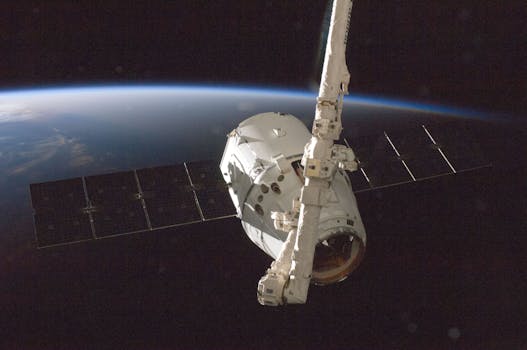
GEO satellites, short for Geostationary Earth Orbit satellites, are a type of satellite that orbits the Earth at an altitude of approximately 36,000 kilometers above the equator. At this height, they remain stationary relative to a fixed point on the Earth’s surface, allowing for continuous communication and observation. The focus keyword for this article is GEO satellites, and we will explore their significance, applications, and future developments.
The concept of GEO satellites dates back to the 1940s, when science fiction writer Arthur C. Clarke proposed the idea of using geostationary satellites for communication purposes. However, it wasn’t until the 1960s that the first GEO satellite, Syncom 2, was launched. Since then, numerous GEO satellites have been launched, providing a range of services including telecommunications, broadcasting, weather forecasting, and navigation.
One of the primary advantages of GEO satellites is their ability to provide continuous coverage of a specific region. This makes them ideal for applications such as television broadcasting, where a signal needs to be transmitted to a wide audience. GEO satellites are also used for satellite communications, providing internet connectivity to remote or underserved areas. Additionally, they play a critical role in weather forecasting, as they can monitor cloud patterns, storm systems, and other meteorological phenomena.
In recent years, there has been a growing interest in GEO satellites due to their potential for providing high-speed internet access. Companies such as SpaceX and Amazon are launching constellations of GEO satellites to provide global internet coverage. These constellations, consisting of thousands of small satellites, will offer faster and more reliable internet access than traditional satellite internet services.
Despite the many advantages of GEO satellites, there are also some challenges associated with their use. One of the main concerns is the risk of collisions with other satellites or space debris. As the number of satellites in geostationary orbit increases, the risk of collisions also rises. Furthermore, GEO satellites are vulnerable to solar flares and other space weather events, which can disrupt their operations.
In conclusion, GEO satellites play a vital role in modern satellite communications, providing a range of services including telecommunications, broadcasting, and weather forecasting. As the demand for satellite-based services continues to grow, the importance of GEO satellites will only increase. With ongoing advancements in technology and the development of new constellations, the future of GEO satellites looks bright.
The use of GEO satellites has also led to the development of new technologies and applications. For example, the use of GEO satellites for navigation has enabled the creation of precision agriculture systems, which use GPS and other satellite-based technologies to optimize crop yields and reduce waste. Additionally, GEO satellites are being used for environmental monitoring, such as tracking deforestation and monitoring ocean health.
Another significant application of GEO satellites is in the field of disaster response and recovery. During natural disasters such as hurricanes, earthquakes, and tsunamis, GEO satellites can provide critical communication services, enabling emergency responders to coordinate their efforts and provide aid to affected areas. Furthermore, GEO satellites can be used to assess damage and identify areas of need, helping to prioritize relief efforts.
In terms of future developments, there are several trends and advancements that are expected to shape the future of GEO satellites. One of the most significant is the increasing use of small satellites, which are smaller and more affordable than traditional satellites. These small satellites are being used for a range of applications, including Earth observation, communications, and technology demonstration.
Another trend is the development of new propulsion systems, which will enable satellites to maneuver more efficiently and extend their lifespan. Additionally, there is a growing interest in the use of GEO satellites for space exploration, such as missions to the Moon and Mars. As space agencies and private companies continue to push the boundaries of space exploration, the role of GEO satellites will become even more critical.
Finally, the use of GEO satellites is also driving innovation in the field of satellite manufacturing. With the increasing demand for satellites, manufacturers are developing new technologies and techniques to improve the efficiency and affordability of satellite production. This includes the use of 3D printing, advanced materials, and automated assembly techniques.
In the context of the broader satellite industry, GEO satellites are just one part of a larger ecosystem. The development of new satellite technologies, such as small satellites and satellite constellations, is driving innovation and growth in the industry. As the demand for satellite-based services continues to increase, the importance of GEO satellites will only continue to grow.
The applications of GEO satellites are diverse and continue to expand. From telecommunications and broadcasting to weather forecasting and navigation, GEO satellites play a critical role in modern society. As technology continues to advance and new applications are developed, the importance of GEO satellites will only continue to increase.
History of GEO Satellites
The history of GEO satellites dates back to the 1940s, when science fiction writer Arthur C. Clarke proposed the idea of using geostationary satellites for communication purposes. Since then, numerous GEO satellites have been launched, providing a range of services including telecommunications, broadcasting, weather forecasting, and navigation.
Applications of GEO Satellites
GEO satellites have a wide range of applications, including telecommunications, broadcasting, weather forecasting, and navigation. They are also used for Earth observation, such as monitoring deforestation and tracking ocean health.
Future Developments
The future of GEO satellites looks bright, with ongoing advancements in technology and the development of new constellations. The use of small satellites, new propulsion systems, and innovative manufacturing techniques will continue to drive innovation and growth in the industry.
Conclusion
In conclusion, GEO satellites play a vital role in modern satellite communications, providing a range of services including telecommunications, broadcasting, and weather forecasting. As the demand for satellite-based services continues to grow, the importance of GEO satellites will only increase.




